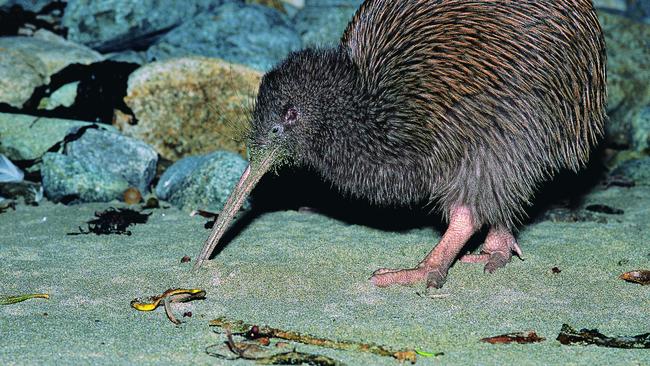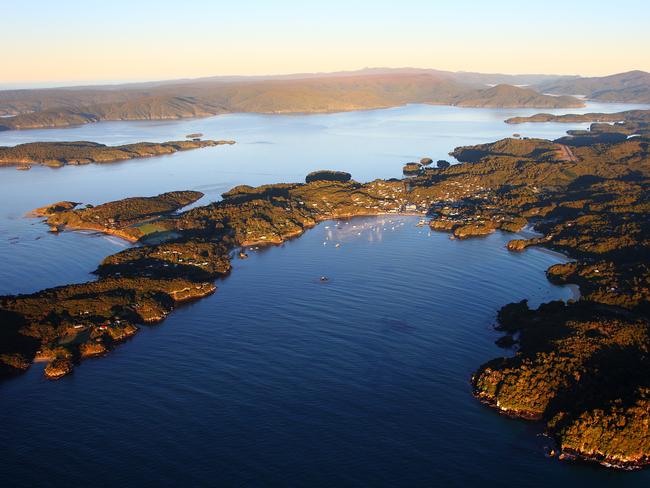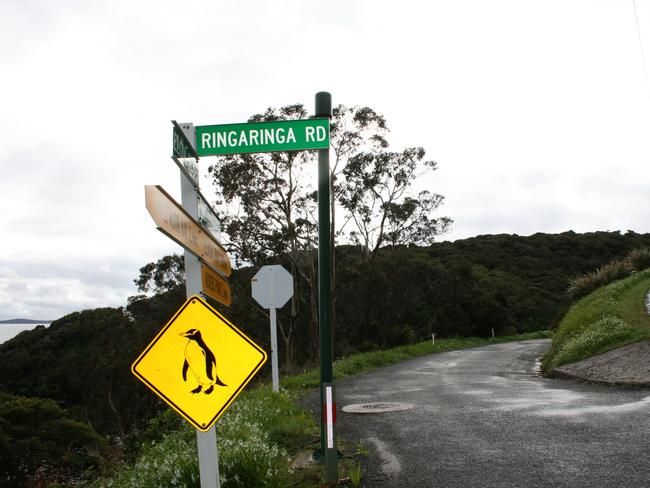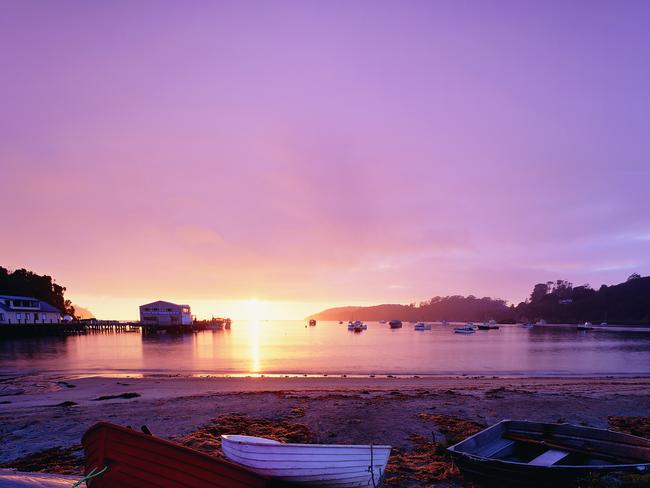Stewart Island, off New Zealand’s South Island, is among the best places to see kiwis in the wild
TAKE a look around a far-flung island that’s known for its shark diving, as well as a far a less fearsome animal attraction.

NZ & Pacific
Don't miss out on the headlines from NZ & Pacific. Followed categories will be added to My News.
AFTER being caged beneath the waves of an icy sea with great white sharks for company, an Australian tourist faces a much mellower but no less memorable early-evening experience: eyeballing kiwis, New Zealand’s flightless national bird, as they forage for worms at the water’s edge. For some visitors, the two combine to create a dream day on Stewart Island.
Throughout a 10-minute boat ride from one part of this far-flung New Zealand isle to another – where we’re promised there’ll be kiwis in the wild – the Brisbane tourist regales her four fellow travellers with every detail of her dramatic encounter.
“Its razor-sharp teeth were right outside my cage,” she reveals.
“It was enormous and looked ravenous. I was its intended prey – and very, very scared. I remember thinking: ‘Now I know why they made me pay in advance.’
“Thank God I was inside a cage!”
Clearly, her adrenalin rush hasn’t quite subsided.
Caged diving, Stewart Island’s newest attraction, remains locally controversial. Those in favour insist it boosts tourism. Those against believe economic benefits are outweighed by dangers associated with luring these giant predators close to shore – just to provide thrills for tourists.
The debate continues.

But we’re on our way to see kiwis, chicken-sized avian oddities related to the long-extinct moa, another trans-Tasman bird. Long-beaked kiwis, which live for up to 30 years and choose mates for life, have been part of the New Zealand landscape for several million years.
They’re so much a national symbol that New Zealanders proudly refer to themselves as kiwis.
Our path winds deep into dense cool-climate forest. Expectations rise. But, after 20 minutes we follow our guide’s advice and turn back – disappointed that we’ve seen none and feeling like abject failures.
Then, just as we’re about to jump back on to our boat, we spot four kiwis nosing around near the water’s edge for worms and insects.
For 10 minutes we watch, intrigued by these peculiar creatures until one suddenly scurries off into the bush, and is soon followed by the others.
“Stewart Island is one of New Zealand’s best locations to see kiwis in their natural habitat,” tour guide Furhana Ahmad says. “They’re generally hard to spot – but not here.”

Ahmad, a keen birdwatcher, fell in love with Stewart Island while on a backpacking trip and dreamt of making this “green and gorgeous” isle her home.
A Kenyan-born British resident of Indian heritage, she made plans to move permanently to New Zealand. She laughingly recalls that mentioning Stewart Island “probably wasn’t the wisest strategy” in interviews with immigration officials.
“They were highly suspicious. Perhaps I should’ve said Auckland.”
But her permanent residency application was approved. She’s lived on Stewart Island for more than a decade and now runs a tour company called Ruggedy Range. She and her trained guides take tourists on trips ranging from easy 30-minute forest rambles to challenging 11-night camping hikes deep into Rakiura National Park (including the famed Rakiura Track) with some kayaking required. In between these extremes, many other options exist.
“We get ordinary tourists throughout the year except for winter, when those opting for longer itineraries tend to be experienced hikers,” Ahmad observes.
“Winters are cold reminders that there’s nothing between us and Antarctica, but for the rest of the year we have a sunny, temperate climate.”

A popular “easy” option is neighbouring 770ha Ulva Island. An uninhabited fauna and flora sanctuary, its bird life includes native parrots and a sorely endangered penguin species. “It’s utterly unspoilt – like New Zealand must have been before people arrived,” Ahmad says.
Stewart Island itself, with only 380 residents, was formerly a fishing outpost but in recent years the No. 1 earner has been tourism. Most people live in Oban, the tiny “capital”, with its ferry terminal, pub, museum and a handful of shops.
Imagine New Zealand’s big North and South islands as the long part of an exclamation mark. The dot at the bottom is 1746sq km Stewart Island – 85 per cent of which is within Rakiura National Park. (Rakiura is also the Maori name for Stewart Island.)

On my second evening in Oban, I take an uphill stroll to Church Hill Restaurant and Oyster Bar, the island’s best eatery and also – perhaps surprisingly, given its address – widely lauded as one of New Zealand’s best.
I’m determined to try a recommended delicacy, mutton bird (a type of shearwater seabird), which the eatery highlights as much as it showcases local lamb and seafood (oysters, mussels, lobsters and freshly-caught fish).
As I’d been told, roasted mutton bird is on the menu.
“How would you describe the taste?” I ask my waiter.
He thinks for a moment, then suggests it’s “like duck marinated in anchovies”.
This proves to be a very accurate description of an extremely tasty dish.

ESCAPE ROUTE
STEWART ISLAND
GETTING THERE
From far-southern Invercargill on New Zealand’s South Island, take a 15-minute hop on regional airline Stewart Island Flights or drive to Bluff, Invercargill’s port, for 30km ferry trips across Foveaux Strait aboard a Stewart Island Experience vessel.
See stewartislandflights.com and stewartislandexperience.co.nz
STAYING THERE
No big chain hotels. A choice of B&Bs and motels, from luxurious through mid-market to budget (including backpacker accommodation). A comfortable B&B: six-room garden-setting Stewart Island Lodge. The lone pub, South Sea Hotel, has a restaurant, bar and motel wing.
See stewartislandlodge.co.nz, stewart-island.co.nz (leave out the hyphen and you’ll reach the tourist information website, which kindly links to the South Sea Hotel’s site).
TOURING THERE
On your way to or from, visit Invercargills’s museum with its replicated habitat stocked with live tuataras. Tuataras? These rare, lizard-like creatures, almost impossible to see in the wild, are the world’s oldest surviving life form — unchanged over millions of years.
A little further north, Dunedin and the adjacent Otago Peninsula anchor New Zealand’s “wildlife strip” with an albatross breeding site, endangered yellow-eyed penguins and sea lions.
WHEN TO GO
Rainy winters are low-season, attracting hardy visitors. Otherwise, this temperate destination boasts many sunny days. Tour operators such as Rugged Range advise whether planned activities may be weather-affected.
See ruggedyrange.com
MORE
See stewartisland.co.nz, newzealand.com
Originally published as Stewart Island, off New Zealand’s South Island, is among the best places to see kiwis in the wild
